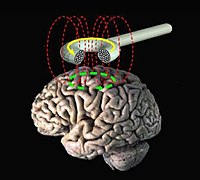
Photo from wikipedia
Coincidence detection and cortical rhythmicity are both greatly influenced by neurons' propensity to fire bursts of action potentials. In the neocortex, repetitive burst firing can also initiate abnormal neocortical rhythmicity… Click to show full abstract
Coincidence detection and cortical rhythmicity are both greatly influenced by neurons' propensity to fire bursts of action potentials. In the neocortex, repetitive burst firing can also initiate abnormal neocortical rhythmicity (including epilepsy). Bursts are generated by inward currents that underlie a fast afterdepolarization (fADP) but less is known about outward currents that regulate bursting. We tested whether Kv2 channels regulate the fADP and burst firing in labeled layer 5 PNs from motor cortex of the Thy1-h mouse. Kv2 block with guangxitoxin-1E (GTx) converted single spike responses evoked by dendritic stimulation into multispike bursts riding on an enhanced fADP. Immunohistochemistry revealed that Thy1-h PNs expressed Kv2.1 (not Kv2.2) channels perisomatically (not in the dendrites). In somatic macropatches, GTx-sensitive current was the largest component of outward current with biophysical properties well-suited for regulating bursting. GTx drove ~40% of Thy1 PNs stimulated with noisy somatic current steps to repetitive burst firing and shifted the maximal frequency-dependent gain. A network model showed that reduction of Kv2-like conductance in a small subset of neurons resulted in repetitive bursting and entrainment of the circuit to seizure-like rhythmic activity. Kv2 channels play a dominant role in regulating onset bursts and preventing repetitive bursting in Thy1 PNs.
Journal Title: Cerebral cortex
Year Published: 2021
Link to full text (if available)
Share on Social Media: Sign Up to like & get
recommendations!